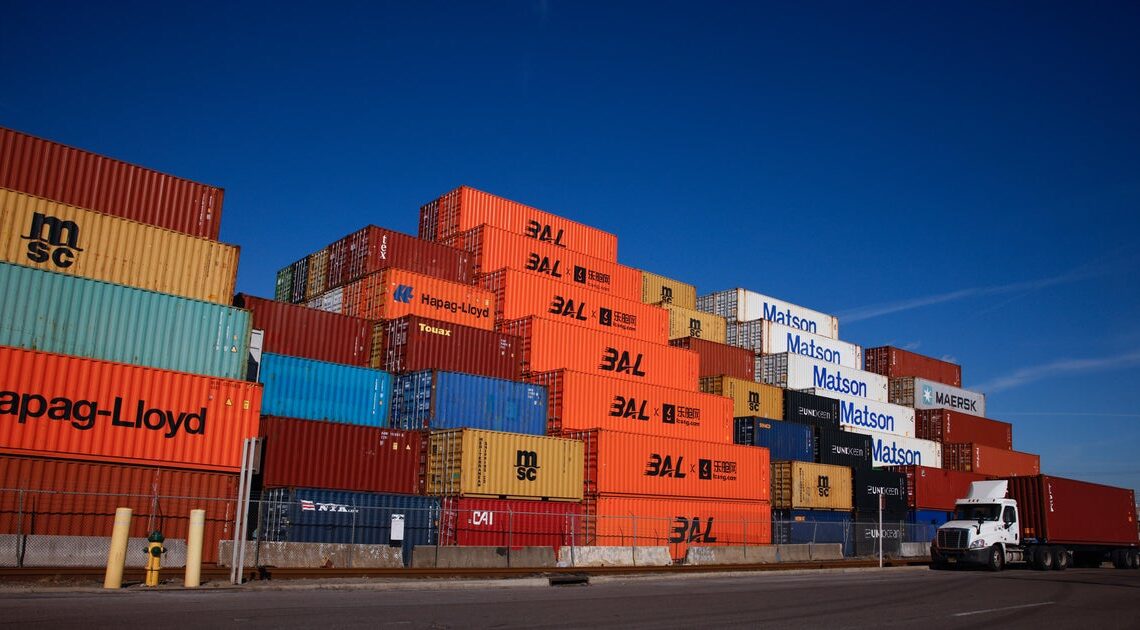
Trump’s sweeping new tariffs in effect, including 104% on goods from China
9. April 2025
President Trump’s tariffs on imports from dozens of countries came into force Wednesday, including 104% on goods from China, dramatically ramping up a potential global trade war. The tariffs took hold at 12:01 a.m. EDT.
Mr. Trump’s tariffs have shaken the dynamics of the decades-old global trading order, increased recession fears and sent shudders through financial markets.
Asian markets resumed their slide Wednesday. Japan’s Nikkei 225 lost 3.9% and Hong Kong’s Hang Seng declined 0.4%, though the Shanghai Composite index turned around early losses, climbing 0.9%. Taiwan’s Taiex plummeted 5.8%. South Korea’s Kospi fell 1.7%.
European shares were lower, with Germany’s DAX down 2.1%, the CAC 40 in Paris declining 2.1% and Britain’s FTSE 100 losing 2%.
U.S. stock futures were reversing earlier declines. S&P 500 futures were 0.07% higher, Dow Jones Industrial Average futures were off 0.18% and Nasdaq Composite futures were up 0.57% as of 5:15 a.m., according to Yahoo Finance.
Following the imposition of sweeping 10 percent tariffs that have rocked the global economy since taking hold over the weekend, levies on imports to the United States from exporters like the European Union and Japan rose further Wednesday.
China — Washington’s top economic rival but also a major trading partner — is the hardest hit.
Deals in the works?
White House press secretary Karoline Leavitt told a briefing Tuesday that the tariffs are designed to open negotiations with U.S. trading partners.
“To countries around the world, bring us your best offers and he will listen,” Leavitt said of Mr. Trump. “Deals will only be made if they benefit American workers.”
Mr. Trump said Tuesday his administration was working on “tailored deals” with trading partners, and the White House said it would prioritize allies like Japan and South Korea.
His top trade official, Jamieson Greer, told a Senate panel Argentina, Vietnam and Israel were among those who had offered to reduce their tariffs.
The president told a dinner with fellow Republicans Tuesday night that countries were eager to reach agreements.
Levies on China stand out
But Beijing has shown no signs of standing down, vowing to fight a trade war “to the end” and announcing and promising countermeasures to defend its interests.
On Wednesday, China’s commerce ministry said the country has a “firm will and abundant means” to fight a trade war with the U.S., adding that Beijing would “resolutely take countermeasures,” state news agency Xinhua quoted the ministry as saying.
Still, a white paper shared by Xinhua Wednesday took a more conciliatory tone, saying, “China and the United States can resolve differences in economic and trade areas through equal-footed dialogue and mutually beneficial cooperation.”
Mr. Trump originally unveiled a 34 percent additional tariff on Chinese goods.
But after China countered with its own tariff of the same amount on American products that’s due to take effect Thursday, the president added another 50 percent duty.
Counting existing levies imposed in February and March, that takes the cumulative tariff increase on Chinese goods during Mr. Trump’s second presidency to 104 percent.
He has insisted the ball is in China’s court, saying Beijing “wants to make a deal, badly, but they don’t know how to get it started.”
What’s behind the tariffs?
The president says his policy will revive America’s lost manufacturing base by forcing companies to relocate to the United States.
But many business experts and economists question how quickly — if ever — that could happen, warning of higher inflation as the tariffs raise prices.
Mr. Trump said Tuesday the United States was “taking in almost $2 billion a day” from tariffs.
More tariffs on the way
Late Tuesday, Mr. Trump also said the United States would announce a major tariff on pharmaceuticals “very shortly.”
Separately, Canada said its tariffs on certain U.S. auto imports will come into force Wednesday.
The European Union has sought to cool tensions, with the bloc’s chief, Ursula von der Leyen, warning against worsening the trade conflict in a call with Chinese Premier Li Qiang.
She stressed stability for the world’s economy, alongside “the need to avoid further escalation,” according to an EU readout.
The Chinese premier told von der Leyen his country could weather the storm, saying it “is fully confident of maintaining sustained and healthy economic development.”
The EU — which Mr. Trump has criticized over its tariff regime — may unveil its response next week to new 20 percent levies it faces.
In retaliation against U.S. steel and aluminum levies that took effect last month, the EU plans tariffs of up to 25 percent on American goods ranging from soybeans to motorcycles, a document seen by AFP says.